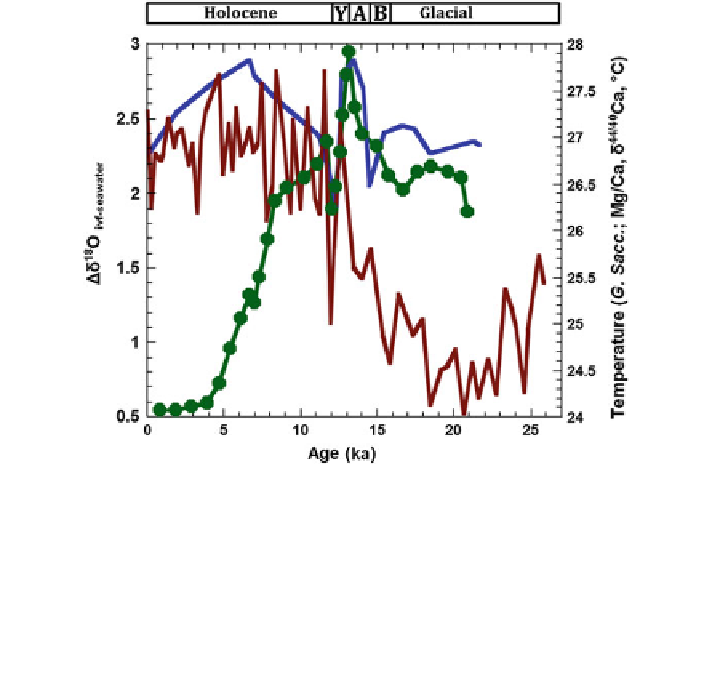Geoscience Reference
In-Depth Information
44/40
Ca (blue) measured on G. sacculifer of core SO164-03-4 are
displayed as a function of time before present. It can be seen that there is no phase shift between the
two records. Furthermore, it can be seen that both the
Fig. 2 Both Mg/Ca (red) and
δ
44/40
Ca record as well as the Mg/Ca record
show about the same pattern for the Holocene but are distinctively different for the Glacial. YYounger
Dryas, A Aller
δ
18
O have been corrected for the glacial/interglacial ice
ø
d, B B
ø
lling. The measured
δ
18
O-record of (ivf ice volume free) and is reported as
18
O
ivf-seawater
volume change applying the
δ
Δδ
18
O
ivf-seawater
are predicted
for the glacial and that maximum salinities are seen for the Aller
ø
d (A) and Younger Dryas (Y) period
(green curve). It can be seen that highest relative salinities expressed as
Δδ
In order to quantitatively account for the SSS change around Termination I we
calculated the
18
O composition of seawater;
18
O
ivf-seawater
“
ice volume free
”
(ivf)
δ
Δδ
44/40
Ca-temperatures and normalized the values to the Holocene
(Fig.
2
) based on
δ
18
O
ivf-seawater
-values occurred
until the Younger Dryas event and subsequently declined in the critical time interval
between 13 and 9 ka BP towards the present day values (Fig.
2
). In general, the
18
O
ivf-seawater
-values show that high
average. The
Δδ
Δδ
18
O
δ
‰
values in the time range between 10 and 15 ka tend to be up to
*
2.5
too heavy in
order to match the Mg/Ca record.
Our initial working hypothesis was that SSS changes are a function of the local
evaporation to precipitation ratio. Hence, any simultaneous local increase of SSS
and SST is lowering the
18
O-gradient to an extent lower than expected by a pure
SST change alone. In the case of core SO164-03-4 the
δ
18
O
ivf-seawater
-variations of
Δδ
up to 2.5
ect such a simultaneous SSS and SST change. Beside a glacial/
interglacial driven SST change, local SSS variations may be generated by any
movement of the Inter-tropical Convergence Zone (ITCZ) center position either to
the north or south, respectively, of its original position. In particular sediment core
SO164-03-4 as well as the Visser et al. (
2003
) cores are from tropical regions and
‰
may re

Search WWH ::

Custom Search